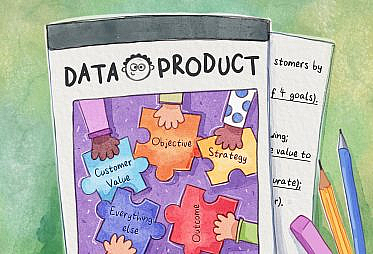The MBR meeting is the focal point of the MBR program. Here you will publicly interrogate KPIs, align on action items and hold people accountable. There are typically three facets to a successful MBR meeting:
- Preparation
- Facilitation
- Follow up
As the MBR lead, many of these responsibilities fall on your shoulders. The MBR meeting is resource intensive, high stakes, and complex given the need to manage both the people and content in the meeting. The success of the MBR will come down to people’s perceptions of how these meetings are run, and the value generated by the action items.
A note about administrative burdens
Before embarking on such a project like the MBR, it’s important to acknowledge how much time and effort it will take. If this time could be better spent on core focus areas such as managing the growth of your team, improving team rituals, or scoping new technologies, then you should reconsider if the MBR is an endeavor worth leading. That said, as you move up the ladder, your core focus will naturally shift towards driving a strong data culture, especially for partners at the executive level. The MBR is a great tool for driving data culture, in particular because it provides a way to hold people accountable for their results in a transparent manner.
However, the administrative burden of the MBR (and similar company-wide processes) is a tax that Analytics leaders will pay. This tax is large early on as you build a structure for data culture (e.g. getting the MBR off the ground) but decreases as you offload some of that burden to others (e.g. a Chief of staff, technical ops partners, perhaps elevating your junior managers) and, crucially, as everyone involved starts to “get it”, including the folks at the top (CEO, COO, …). If you’re spending much of your time chasing folks down to update their content, or follow up on their action items, and you get the sense that the program never really clicks, then it can become a large waste of time.
For these reasons, you must get the executive team involved to help unblock and empower you, and foster the culture of accountability required for the MBR to be successful.
Preparation
Your main objective before each meeting is to ensure everyone’s expectations are set. To reiterate, the purpose of the MBR is to review the most important metrics of the business, hold folks accountable and establish action items. Different parties will have different expectations heading into the meeting, so your job is to ensure those expectations are clear and aligned ahead of time. A few days ahead of each MBR, send a reminder email to the group, include the content that you’ll review in the meeting, and a rough agenda. If someone cannot make it, ensure they send a representative. In parallel, sync with individuals that you know have outstanding content or will have important material to share. Finally, delegate someone with broad business context to take notes so you can focus on keeping the conversations flowing.
Presentation format
As the MBR lead, you need to consider how to deliver the content in the MBR itself. I recommend using a slide deck, shared ahead of the meeting, with a slide for each KPI, beginning with the most pertinent KPIs to the business. A deck is a simple and replicable format for KPI owners to publish their content, and allows attendees a chance to disagree with the topic ordering if they believe something is missing or misprioritized, ahead of the meeting.
Attendees
In general, there are three types of individuals involved in the MBR program (“KPI-owners”):
- Executives or business heads that are the highest level accountable party for a group of KPIs.
- Senior leaders that are responsible for leading specific initiatives and speaking to KPI performance.
- Other individuals that are behind the scenes of the MBR, responsible for developing and reporting metrics, but less likely to be present during the actual meetings.
Everyone involved in the MBR meeting should in some way be responsible for a subset of KPIs — otherwise they shouldn’t be there.
The folks most critical here are the senior leaders, as they manage the work done by individuals working on KPIs while ensuring alignment with executives. Since the MBR is highly cross functional, it’s common that folks responsible for a given set of KPIs are in different reporting lines.
Ahead of the reminder email, KPI-owners will publish their content in the shared MBR document to give other attendees time to review and comment. Otherwise, the MBR can become a read out, surprising folks in real time. This implies that KPI owners should begin drafting their content at least a week in advance to give themselves time to iterate if needed. This is a bigger consideration as you start the program, and becomes more seamless as KPIs stop changing frequently. As the MBR leader, you must remain close to each KPI owner to ensure each section is well presented. You own the content presented in the MBR – this doesn’t mean you are accountable for the results, but rather that if something is unclear, poorly formatted or is simply the wrong metric to be tracking, you must prioritize fixing it.
Facilitation
The goal of meeting facilitation is to cover the most important content, keep the conversations focused and ensure action items are clear.
Prioritize certain KPIs
For the first few iterations, the agenda will cover all KPIs in the MBR. This is the best way to test if the KPIs are indeed the correct ones. After a period of iteration, a broad set of obviously important KPIs will surface — these are the ones to prioritize in subsequent meetings. More specifically, after folks have seen the same KPIs a few times, the meeting should solely focus on triaging poor performing KPIs — all others should be skipped (but KPI owners should continue updating them in case they trend downwards in future sessions).
Keep conversations focused
There are two kinds of rabbit hole conversations that, as the meeting facilitator, it’s your job to redirect. The first is technical KPI definition and refinement. For example, someone may take issue with tracking user growth on a monthly instead of weekly basis. Another person may want to see it plotted as a time series instead of week over week % increases. While important to discuss, this should be done offline and ahead of the meeting. Ask your delegated note taker to jot this down and you can follow up afterwards.
The second type of rabbit hole is strategic; these conversations may begin with innocent sounding questions like “Why are we pursuing this at all?” or “I thought we had stopped this partnership.” In this case, a minute or so of conversation can be helpful in unearthing fundamental misalignment to follow up offline. However, the goal is not to come to a resolution in the meeting. Set a timer in the background and if after 3 minutes folks are still talking about something that isn’t the KPI itself, end the conversation, note that you’ll follow up and move on. Keep the meeting focused on KPIs and initiatives, not strategy.
Follow Up
A core part of your responsibility is to ensure everyone leaves the meeting with a clear understanding of their action items. The MBR lead should summarize the discussion, highlight individuals’ action items, and broadly communicate the outcomes of the MBR.
Note that some action items will require your heavy involvement, for example, working with Sales to redefine a Revenue KPI. Other action items, for example increasing call center staffing, fall squarely outside of the purview of Analytics. To help ensure accountability, you should create a mechanism (a simple spreadsheet works) for folks to update the group on their progress against action items between meetings. This way you’re not chasing people down, the follow-up process is transparent, and there are fewer surprises (say, in case the action item wasn’t resolved) when the next meeting begins.
If there are meaningful changes to the MBR as a result of an action item, you should communicate this in advance of the following MBR. It is helpful to socialize significant changes – for example, redefining an existing KPI – to individuals directly impacted by the change. Then broadly communicate these changes in the MBR reminder email ahead of the next meeting.
Company wide communications
Folks outside of the core MBR participants will want to see the content that was shared and understand follow ups. Depending on your organization’s size, culture and general MO, it may make sense for this company wide communications to come from an executive, Chief of Staff, or Analytics leader. Regardless, consider how people who lack appropriate context will receive the information in the MBR. Aim to balance the tension between providing too much information and not enough. Always leave it open to answer one-off questions folks may have, rather than trying to communicate in a way that satisfies everyone.
For example, an Operations Associate may lack the context around why a Product decision was made that led to a decrease in a customer retention KPI. Explaining this background detail to catch them up to speed isn’t scalable across the company (and for all KPIs). On the other hand, if the MBR mentions something obviously significant — say, no longer supporting EURO currency on the website — some context should be provided in a summary email or other communication to get ahead of potential confusion.
Successful facilitation leads to a successful MBR
The MBR program’s success hinges on well-run business review meetings. You must ensure everyone involved is clear about their expectations, the meeting is streamlined with the most relevant topics discussed, and that folks have action items exiting the meeting. You should then ensure follow ups happen by making it easy for folks to update the group on their progress. If the meeting runs well and action items are followed up, folks will derive a lot of value out of the MBR and consider it a useful tool in helping them improve their business lines.
What do you find works best in ensuring an effective KPI meeting? Let me know in the Slack!






